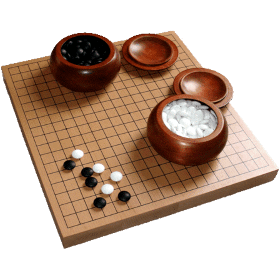Ґо
 У грі Ґо гравці по черзі розміщують камені на порожніх перетинах сітки 19x19. Мета гри — оточити територію за периметром каменів і, по-друге, щільно оточити і захопити камені супротивника.
У грі Ґо гравці по черзі розміщують камені на порожніх перетинах сітки 19x19. Мета гри — оточити територію за периметром каменів і, по-друге, щільно оточити і захопити камені супротивника.
Кількість гравців: 2
Тривалість гри: 29 mn
Складність: 2 / 5
Грати Ґо та 1194 інших ігор онлайн.
Нічого не треба завантажувати, грайте безпосередньо з вашого браузера.
З вашими друзями й тисячами гравців з усього світу.
Безплатно.

Грати Ґо та 1194 інших ігор онлайн.
Нічого не треба завантажувати, грайте безпосередньо з вашого браузера.
З вашими друзями й тисячами гравців з усього світу.
Безплатно.

Огляд правил
BoardGameArena uses the American Go Association's rules for this adaptation.
For tips on how to play go, see Tips_ClassicGo
Basic rules
A summary loosely based on "The Rules and Elements of Go" (1977) by James Davies:
- Black moves first.
- Black and White alternate placing one stone of their own colour on an empty intersection on the board.
- A stone or connected group of stones of one colour is captured and removed from the board when stones of the opposite colour occupy all the intersections directly adjacent to it.
- Only cardinally adjacent intersections connected by grid lines matter when considering whether stones are connected, and when considering whether a group of stones is captured. Diagonals and intersections 2+ away do not count.
- Any move that results in the immediate capture of the placed stone is not allowed (self-capture).
- Capture of the opponent takes precedence over self-capture: placing a stone into a position where it would be immediately captured is allowed if the move captures opposing stones. (See Fig. 1 below)
- No stone may be played so as to recreate a former board position. If a stone is played anywhere else on the board, this creates a "different board position" for that player's next turn. (See Fig. 2 below)
- A player may pass their turn at any time.
- Two consecutive passes end the game. All "dead" stones that inevitably can be captured are removed from the board at this time. If players cannot agree whether a group of stones is dead or not, play will resume to determine the status of the group.
- The player with more area at the end of the game wins. A player's area consists of all grid intersections they have either occupied or surrounded in their colour. Score can also be counted by territory: intersections surrounded + prisoner stones captured.
Tiebreaker and first move compensation
If players have equal points at end of game, then white wins by +0.5 points. White is sometimes given additional points as komi to compensate for going second (see Komi and handicaps under Game options below).
Game options
Grid size
Game board size. Available values are:
9x9 is a shorter game and recommended for beginners.
Method of counting
Method for counting the score. Options are:
- Japanese (territory scoring: each surrounded intersection is worth one point, and each stone captured from an opponent is worth one point)
- Chinese (area scoring: each surrounded intersection is worth one point, and each stone of your colour remaining on the board at the end of the game is worth one point)
If AGA Rules are on (See "AGA Rules" below), no matter which counting method is used, the difference between the two players' scores, and the game result, is the same (territory scoring gives points when a player captures stones, and area scoring takes away points when a player's stones are captured).
Some people find area/Chinese scoring more intuitive. Territory/Japanese scoring is faster to mentally check during a game, but beginners usually do not need to count score in the middle of a game.
There are situations (Japanese seki) in which a region of empty points is left at the end of the game which is not entirely surrounded by stones of a single colour, and which neither player would fill because to do so would lead to the capture of their own stones.
Komi and handicaps
Komi are extra points given to White to compensate for Black's first move advantage. An even game for strong players is around 7 komi points on all board sizes.
A game may be played with a handicap to compensate for differences in player strengths. On BGA, the administrator of the table plays White, and the other player plays Black. The stronger player in a handicap game should create the table and play White. With "Handicap: 1 stone," Black moves first, and gives only 0.5 compensation points to White (to break ties). With the other handicap options, Black begins the game with 2 to 9 stones on predefined intersections, White gets only 0.5 compensation points, and White moves first.
Options are:
- Without komi (without compensation)
- Normal komi (4 points for 19x19 and 5 points for 9x9, 13x13)
- Big komi (for strong players: 7 points for 9x9, 13x13, 19x19)
- Handicap: 1 stone
- Handicap: 2 stones
- Handicap: 3 stones
- Handicap: 4 stones
- Handicap: 5 stones
- Handicap: 6 stones
- Handicap: 7 stones
- Handicap: 8 stones
- Handicap: 9 stones
AGA Rules
A yes/no option for using the American Go Association rules. AGA rules specify that a player who passes must give the opponent one point, and that White must pass last at the end of the game (passing a third consecutive time if necessary). This ensures that area/Chinese counting and territory/Japanese counting always give exactly the same result. If AGA rules are turned off, playing a stone within your own territory loses one point under territory/Japanese counting, but does not affect the score in area/Chinese counting.
When set to "No", players still pay one point for passing when playing out after the end of the game to determine the life/death status of disputed groups.

